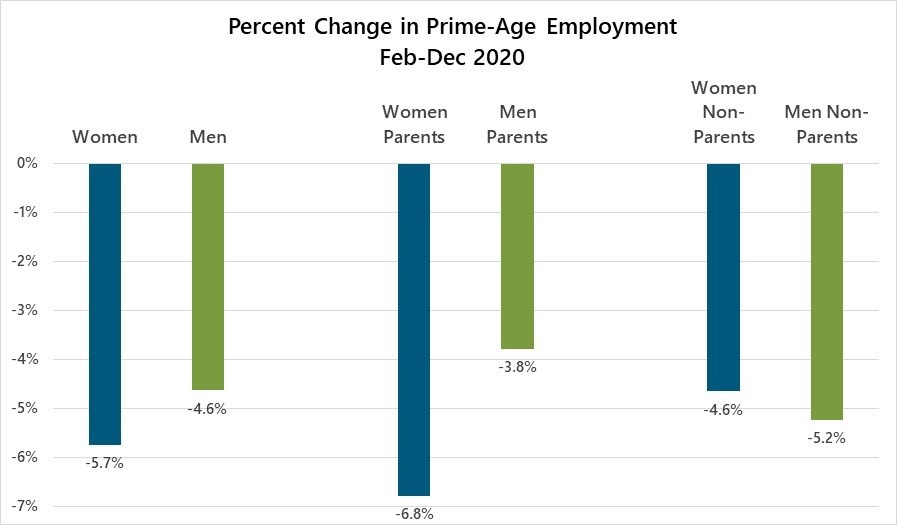Building fairer fiscal systems: Principles and tools to design a holistic approach for closing gender gaps – Brookings

Report on Fiscal Policy’s Role in Achieving Sustainable Development Goals on Gender Equality and Economic Inclusion
Persistent economic disparities between men and women present a significant obstacle to achieving multiple Sustainable Development Goals (SDGs), including SDG 5 (Gender Equality), SDG 1 (No Poverty), SDG 8 (Decent Work and Economic Growth), and SDG 10 (Reduced Inequalities). These gaps, stemming from women’s overrepresentation in lower-income households and their disproportionate share of unpaid care work, not only disadvantage women but also undermine broader economic prosperity and human rights. Effective fiscal policy is a critical instrument for addressing the root causes of these inequalities and accelerating progress towards the 2030 Agenda.
This report outlines how a holistic approach to fiscal policy, integrating tax and social spending measures, can effectively reduce gender-based economic gaps. It emphasizes that policy choices must be tailored to local contexts, considering drivers of inequality and administrative capacity, to ensure that efforts to raise domestic revenue (a key component of SDG 17) are equitable and support inclusive growth.
A Holistic Fiscal Framework for Advancing the SDGs
An integrated fiscal framework that combines tax and social spending is more effective in reducing income inequality than isolated policy measures. The impact of such a framework varies by country, but analysis shows that direct taxation and social spending on health (SDG 3), education (SDG 4), and social protection (SDG 1) are the most potent tools for redistribution. A holistic approach aims to balance three core objectives: redistribution, revenue generation, and economic incentives, ensuring the overall system advances gender equality and poverty reduction.
Aligning Tax Systems with SDG 5 and SDG 10
To support gender equality and reduce inequality, tax systems should be designed to be progressive, transparent, and neutral, minimizing economic distortions and compliance costs. This approach supports SDG 10 by ensuring a fair distribution of the tax burden and SDG 17 by strengthening domestic resource mobilization. Key policy options include:
- Progressive Personal Income Tax (PIT): Implementing comprehensive PIT systems with rising marginal rates that tax all income sources equally is more effective at reducing gender income gaps, as capital ownership is highly concentrated. This helps achieve the aims of SDG 10.
- Minimizing Work Disincentives: Tax and benefit systems should be designed to avoid penalizing low-wage or secondary earners, who are predominantly women. This supports female labor force participation, a crucial element of SDG 5 and SDG 8.
- Corporate Income Tax (CIT): Aligning CIT rates with top PIT rates can prevent income sheltering and ensure high-net-worth individuals contribute fairly, reinforcing the progressivity of the tax system.
- Broad-Based Consumption Taxes: While potentially regressive, a broad-based Value Added Tax (VAT) with a uniform rate is an efficient revenue-raiser. Its regressive effects can be more effectively offset by targeted cash transfers to low-income groups rather than through complex exemptions, which often benefit higher-income households more.
Leveraging Social Spending to Achieve SDG 1 and SDG 5
Social spending is a direct and powerful tool for reducing poverty and gender inequality. When designed effectively, these programs can address the underlying constraints women face, contributing directly to multiple SDGs.
- Cash Transfers: Non-contributory, poverty-targeted cash transfers are highly effective in reducing poverty (SDG 1). When directed at individuals rather than households, they can specifically address women’s poverty and enhance their economic autonomy (SDG 5).
- Investment in Care Infrastructure: Subsidies for childcare and gender-neutral paid parental leave lower barriers to women’s participation in the formal labor market. This is essential for achieving decent work for all (SDG 8) and sharing unpaid care work more equally (SDG 5).
- Human Capital Development: In low-income countries, public investment in health (SDG 3) and education (SDG 4) is paramount for closing gender gaps in opportunities.
- Infrastructure Investment: Enhancing infrastructure, such as access to clean water (SDG 6) and sanitation facilities, reduces the time women spend on unpaid domestic work, freeing up time for education and paid employment.
Integrating Complementary Policies for Comprehensive SDG Impact
Fiscal policy reforms are most effective when implemented as complementary packages. A holistic approach recognizes that economic incentives alone are insufficient to overcome structural barriers rooted in social and cultural norms. Therefore, fiscal reforms must be combined with broader measures that address the unequal distribution of unpaid care work and the types of jobs available to women.
For example, a reform that removes regressive and environmentally harmful fossil fuel subsidies can be paired with targeted social safety net spending. This approach can be revenue-positive while protecting low-income households, thereby advancing SDG 1, SDG 10, and SDG 13 (Climate Action) simultaneously.
The Way Forward: Strengthening Institutions and Data for SDG-Aligned Fiscal Policy
Effective, evidence-based policy design requires robust data and analytical capacity, which are foundational for building the strong and accountable institutions envisioned in SDG 16. A major obstacle, particularly in low- and middle-income countries, is the lack of joined-up data and the capacity to analyze it through a gender lens.
Enhancing Data Infrastructure for Evidence-Based SDG Implementation (SDG 16 & 17)
To design and evaluate fiscal policies that effectively address gender gaps, governments must invest in data infrastructure. This aligns with SDG 17’s call for high-quality, timely, and reliable disaggregated data. Key data sources include:
- Sex-Disaggregated Survey Microdata: Household income and expenditure surveys provide granular detail on socio-economic conditions and disparities.
- Administrative Records: Comprehensive data from tax authorities and social benefit programs, when linked, offer a powerful tool for understanding the real-world impact of fiscal policies.
- Beneficial Ownership Registers: Increased transparency on the assets and incomes of high-net-worth individuals and corporations is crucial for measuring and taxing wealth and income accurately.
Investing in Analytical Capacity for Effective Policy Design
Generating data is only the first step. Governments must also build the institutional capacity to analyze and apply this data in policymaking. This involves investing in methods and modeling tools to assess the distributional and behavioral impacts of fiscal policies on men and women.
Distributional analysis models, such as microsimulation models, are essential for evaluating the ex-ante and ex-post impacts of policy reforms on poverty and inequality. By quantifying the incidence of taxes and benefits across different household types, these tools enable policymakers to design more equitable and efficient fiscal systems that accelerate progress toward the Sustainable Development Goals.
Analysis of Sustainable Development Goals in the Article
1. Which SDGs are addressed or connected to the issues highlighted in the article?
- SDG 1: No Poverty – The article discusses how fiscal policies, such as targeted cash transfers and social spending, can reduce income poverty, particularly for women and low-income households.
- SDG 3: Good Health and Well-being – The text mentions the importance of social spending on health as a key investment in human capital to narrow gender gaps, especially in low-income countries.
- SDG 4: Quality Education – Similar to health, the article identifies spending on education as a crucial component of fiscal policy for investing in human capital and reducing gender inequalities in opportunities.
- SDG 5: Gender Equality – This is the central theme of the article, which focuses on analyzing and addressing the “significant and persistent income and employment gaps” between men and women through fiscal policy, tackling issues like unpaid care work and vulnerable employment.
- SDG 8: Decent Work and Economic Growth – The article advocates for policies that “facilitate women to access and keep quality and well-paid employment” and move away from “vulnerable employment conditions,” while fostering “sustainable, inclusive economic growth.”
- SDG 10: Reduced Inequalities – The core argument is that fiscal policy, including progressive taxation and social spending, is a key tool for reducing income inequality within countries, including the economic disparities between men and women.
- SDG 16: Peace, Justice and Strong Institutions – The article emphasizes the need for “well-functioning tax administration,” transparency, and evidence-based policymaking supported by better data collection to create fairer and more effective fiscal systems.
2. What specific targets under those SDGs can be identified based on the article’s content?
- Under SDG 1 (No Poverty):
- Target 1.3: Implement nationally appropriate social protection systems and measures for all, including floors, and by 2030 achieve substantial coverage of the poor and the vulnerable. This is addressed through the discussion on using “targeted cash transfers,” “social safety nets (SSNs),” and combining “contributory and non-contributory schemes” to support low-income groups and reduce poverty.
- Under SDG 5 (Gender Equality):
- Target 5.4: Recognize and value unpaid care and domestic work through the provision of public services, infrastructure and social protection policies. The article directly addresses this by noting that “women perform a higher share of unpaid work” and suggests policies like “provision of care for children and the elderly, gender-neutral parental leave, and flexible work arrangements.”
- Target 5.5: Ensure women’s full and effective participation and equal opportunities for leadership at all levels of decision-making in political, economic and public life. The article’s focus on policies that “facilitate women to access and keep quality and well-paid employment” and support “women’s economic participation” directly relates to the economic aspect of this target.
- Under SDG 8 (Decent Work and Economic Growth):
- Target 8.5: By 2030, achieve full and productive employment and decent work for all women and men, including for young people and persons with disabilities, and equal pay for work of equal value. The article’s emphasis on closing “income and employment gaps,” ensuring “quality and well-paid employment,” and moving women out of “vulnerable employment conditions” aligns with this target.
- Under SDG 10 (Reduced Inequalities):
- Target 10.4: Adopt policies, especially fiscal, wage and social protection policies, and progressively achieve greater equality. The entire article is a detailed argument for using fiscal policy—specifically “progressive personal income taxation” and “social spending”—as the primary lever to reduce income inequality.
- Under SDG 16 (Peace, Justice and Strong Institutions):
- Target 16.6: Develop effective, accountable and transparent institutions at all levels. This is reflected in the call for a “well-functioning tax administration,” reducing compliance costs, and making tax systems “simple, transparent, and neutral.” The push for evidence-based policy design also supports institutional effectiveness.
3. Are there any indicators mentioned or implied in the article that can be used to measure progress towards the identified targets?
- Implied Indicators for SDG 5:
- The article’s focus on “income and employment gaps” implies the use of indicators such as the gender pay gap and the difference in labor force participation rates between men and women.
- The discussion of women performing a “higher share of unpaid work” points to the relevance of Indicator 5.4.1: Proportion of time spent on unpaid domestic and care work, by sex, age and location, which would be measured through time-use surveys.
- Implied Indicators for SDG 8:
- The mention of women being “more likely to be second and low-wage earners or own-account workers under vulnerable employment conditions” suggests measuring the proportion of women in vulnerable employment and tracking average hourly earnings of female vs. male employees (related to Indicator 8.5.1).
- Implied Indicators for SDG 10:
- The article’s analysis of how fiscal policy reduces “within-country income inequality” implies the use of metrics like the Gini coefficient to measure the distribution of income before and after taxes and transfers.
- Implied Indicators for SDG 16 and Data-related Goals:
- The call for “better quality and more joined up data” and “sex-disaggregated data” to understand gender gaps directly implies the need to track progress on Indicator 17.18.1: Statistical capacity indicator for Sustainable Development Goal monitoring, with a specific focus on the availability of disaggregated data.
4. Table of SDGs, Targets, and Indicators
| SDGs | Targets | Indicators (Mentioned or Implied) |
|---|---|---|
| SDG 1: No Poverty | 1.3: Implement nationally appropriate social protection systems. | Coverage of population by social safety nets and cash transfers; reduction in poverty rates. |
| SDG 5: Gender Equality | 5.4: Recognize and value unpaid care and domestic work. 5.5: Ensure women’s full and effective participation and equal opportunities in economic life. |
Proportion of time spent on unpaid care work (by sex); Gender pay gap; Labor force participation rate (by sex). |
| SDG 8: Decent Work and Economic Growth | 8.5: Achieve full and productive employment and decent work for all women and men. | Proportion of women in vulnerable employment; Average hourly earnings (by sex). |
| SDG 10: Reduced Inequalities | 10.4: Adopt policies, especially fiscal, wage and social protection policies, to achieve greater equality. | Gini coefficient (before and after taxes/transfers); Impact of fiscal policy on income distribution. |
| SDG 16: Peace, Justice and Strong Institutions | 16.6: Develop effective, accountable and transparent institutions at all levels. | Availability of timely, reliable, and sex-disaggregated data for policymaking; Measures of tax administration efficiency. |
Source: brookings.edu

What is Your Reaction?
 Like
0
Like
0
 Dislike
0
Dislike
0
 Love
0
Love
0
 Funny
0
Funny
0
 Angry
0
Angry
0
 Sad
0
Sad
0
 Wow
0
Wow
0



















































.jpg.webp?itok=0ZsAnae9#)

























